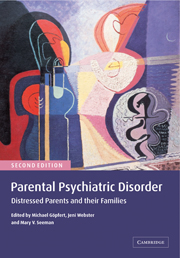Book contents
- Frontmatter
- Contents
- List of contributors
- Foreword
- Preface
- Part I Basic issues
- Part II Comprehensive assessment and treatment
- Part III Specific disorders: the impact on parent–child relationships
- 11 Schizophrenia and motherhood
- 12 When a parent suffers from an affective disorder: effect on the child
- 13 Alcohol and drug problems in parents: an overview of the impact on children and implications for practice
- 14 When mothers abuse drugs
- 15 Personality disorder in parents: developmental perspectives and intervention
- Part IV Specific treatments and service needs
- Part V Child-sensitive therapeutic interventions
- Part VI Models for collaborative services and staff training
- Afterword
- Index
- References
14 - When mothers abuse drugs
from Part III - Specific disorders: the impact on parent–child relationships
Published online by Cambridge University Press: 09 August 2009
- Frontmatter
- Contents
- List of contributors
- Foreword
- Preface
- Part I Basic issues
- Part II Comprehensive assessment and treatment
- Part III Specific disorders: the impact on parent–child relationships
- 11 Schizophrenia and motherhood
- 12 When a parent suffers from an affective disorder: effect on the child
- 13 Alcohol and drug problems in parents: an overview of the impact on children and implications for practice
- 14 When mothers abuse drugs
- 15 Personality disorder in parents: developmental perspectives and intervention
- Part IV Specific treatments and service needs
- Part V Child-sensitive therapeutic interventions
- Part VI Models for collaborative services and staff training
- Afterword
- Index
- References
Summary
Although substance abuse was once considered to be predominantly a problem of men, abuse of drugs has become increasingly common in women. In the United States, 7.9% of women between the ages of 14 and 44 use illicit drugs such as cocaine and heroin (Office of Applied Studies, 1999), and approximately 3 million women use these drugs on a regular basis (National Center on Addiction and Substance Abuse, 1996). Most substance-abusing women serve as custodial parents to their children.
Children whose mothers abuse illicit drugs are at risk for developmental problems. During middle childhood and adolescence, they show high levels of delinquency and other conduct problems as well as internalizing problems such as depression and anxiety (Stanger et al., 1999; Wilens et al., 1995). During infancy and early childhood, they show subtle developmental delays and problems with regulation of attention and affect (Hans, 1998).
A variety of factors may place children of substance abusers at risk. Most public attention has focused on the possible adverse effects of prenatal exposure to drugs on the developing brain. During the early 1990s, grave concerns were raised about the problem of ‘crack babies’ and predictions were made that such children would be emotionally disturbed and uneducable and would overwhelm the capacities of schools and social service agencies. Although such dire predictions proved unfounded (Mayes et al., 1992), a growing body of research has documented subtle behavioural alterations related to prenatal exposure to drugs that remain of significant public health concern (Lester et al., 1998).
Keywords
- Type
- Chapter
- Information
- Parental Psychiatric DisorderDistressed Parents and their Families, pp. 203 - 216Publisher: Cambridge University PressPrint publication year: 2004
References
- 2
- Cited by



